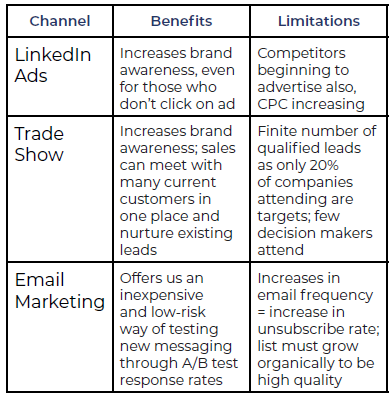
How to Calculate
Marketing ROI
How to Calculate Marketing ROI
The return on your marketing investment (ROI) is essential to understanding the performance of your marketing programs, but every “how-to” article we’ve read assumes we already have several pieces of information at hand that the majority of marketers do not. In this post, we break down step-by-step how to calculate each and every piece you need – from scratch.
For far too many companies, understanding the return on their marketing investment remains elusive. As a result, many businesses rely solely on metrics reported by their agencies, social media platforms, or the publications in which they advertise – all of which are useful, albeit incomplete, snapshots. Or, companies measure their success by the number of leads generated by a given program, which is appropriate for some activities but dangerously irrelevant for others.
In order to understand and compare the value of your marketing efforts in a meaningful way, you must invest the time to calculate your ROI based on four essential pieces of information:
– Your business’ Customer Lifetime Value (LTV)
– Your sales team’s Lead-to-Sale Close Rate
– Your company’s Operating Profit (EBIT) margin, and
– The cost per Lead (CPL) of each marketing activity
But what if you don’t have those data? Don’t worry, they can all be calculated using data every marketer has access to; just follow the steps in our guide, available here.
Download our Guide to Marketing ROI
Once you’ve followed the steps outlined in our guide you’ll have ROI figures for each marketing activity you want to compare. So how do we use it to make decisions? The truth is that this data is downright dangerous without context, which you, the marketer, must provide.
One data set, three conclusions
If you presented this chart to your CFO, she would logically conclude that you should stop participating in the trade show with negative ROI and re-allocate that budget to LinkedIn, the channel with the highest ROI.

If you presented this chart to your sales manager, he would conclude that the best use of budget is the trade show, the channel generating the most revenue. Then again, your digital marketing agency would look at the data and decide that email marketing is the best bang for your buck, the channel with the lowest CPL.
Three stakeholders, each with their own interpretation. So which one is correct? How should we allocate our budget going forward? To make these decisions, we need context.
Data + context = insight
Turning our data into useful insight requires to two pieces of contextual information: channel capabilities and limitations and clearly defined objectives.
Each channel offers a different set of benefits and limitations on those benefits, illustrated to the right using our example data.
Understanding (and explaining to others) benefits which may be more difficult to quantify is important, because you must be conscious of the additional opportunities and efficiencies which would be lost or reduced if budget were re-allocated based solely on ROI calculations.
The limitations of each channel are equally important to understand, because for each channel there is a point of diminishing returns. For example, it’s highly unlikely that doubling the budget for the trade show we analyzed would result in doubled revenue, because there is a finite amount of business potential at the show.

The second piece of contextual information we must understand is our goal or objective. As illustrated in the example of the CFO, sales manager, and digital marketing agency’s differing conclusions from the same data, the “right” decision depends on the goal you’re trying to achieve.
If the goal of both your LinkedIn Ads and your Email Marketing are to generate leads, it makes sense to compare the two CPLs and ROIs when allocating budget. But, if the goal of your LinkedIn Ads is brand awareness, as is your Trade Show, comparing their performance by ROI based on leads generated does not make sense.

In this paper we have used leads as the basis of our calculations, because it is a goal familiar to nearly every business and because leads are more easily measured than other objectives. Of course, lead generation is just one of many possible objectives you may have for your marketing programs. Here are others you should consider when evaluating channel performance:
– Brand awareness
– Product awareness
– Customer satisfaction and loyalty
– Audience engagement
While these objectives may be difficult to convert to revenue or profit gained, comparing them to industry benchmarks and your own historic performance offers valuable insight into the effectiveness of your marketing program in meeting these goals.
Your marketing ROI measurement strategy should be customized to your specific business objectives and marketing mix. For help creating and implementing your customized plan, contact the experts at Freshwater Marketing.
Request a quote
Let us know a bit about yourself, your business, and the kind of marketing support you need, and we’ll be in touch.


